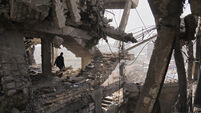Europe warned it needs migrants
But the UN warned the numbers are not nearly enough.
It warns that Europe's population is set to drop by 20% if the average number of foreigners does not increase dramatically over the next few decades.
Every country will be affected as the burden on those working will increase hugely, resulting in some countries, like Spain, having almost every working person supporting one non-working person such as a child or elderly person by 2050.
The situation is expected to be a little better in Ireland but will get worse as the population ages and birth rates continue to fall.
The number of migrants in Ireland doubled from 80,000 in 1990 to 182,000 in 2001, while in the 15 old EU member countries and Switzerland they increased from around 16 million to just under 21m.
The current clampdown by Europe on foreigners comes at a time when birth rates are falling and migration into the world's developed countries has slowed.
In the ten years from 1990 to 2000 the number of refugees and asylum seekers has dropped too, from 16m to 12m as long-standing conflicts worldwide came to an end.
Europe's population would have shrunk by 4.4m over the five years from 1995 if it were not for the arrival of five million migrants during that time. Germany's population would have been declining since 1970 were it not for incoming workers.
The situation is even worse in the new EU member states and in Russia, where fertility rates are even lower than in the west.
UN official Jose Antonio Ocampo said migration can help prevent reductions in the working-age population in developed countries, but people will have to work longer and more people of working age will have to become part of the labour force.
The report says that contrary to popular belief, foreign workers are not a drain on a country's economy, but in fact contribute more than they get. They also do not take jobs from locals or reduce wages.
Presenting the survey in Brussels, Jean-Pierre Gourrot of the UN said they had found an increase in the number of enclaves, where migrants tended to live in ghetto-like situations.













